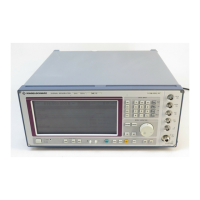Digital Modulation SME
1038.6002.02 2.108 E-13
STATE
ON Switch on of FLEX.
The RF frequency has to be set to the desired value by
means of key [FREQ]. The status line displays the word
FLEX as well as the cycle and frame number and the type
of output data:
SEC secure message
INST instruction to SSID subscriber
TONE tone-only message
NUM numeric message
SNUM special numeric message
ALPH alphanumeric message
BIN binary/hexadecimal message
RSYN emergency resync
---- FLEX frame without message
OTH frame without FLEX structures
If REPEATS is larger than 0 (i.e. FLEX-TD active), only the
first character is displayed for each phase (for SNUM a P
is displayed).
A switchover from STATE OFF to STATE ON results in a
recalculation of the memory extension data and their entry
into the list "XMEM". Changing FLEX parameters except
for MESSAGE GENERATION MODE requires a
recalculation of data. With radiocommunication service
FLEX activated (STATE ON), every parameter change
generates a warning "FLEX setting and output signal
mismatch". The recalculation of data can either be effected
by switchover from STATE OFF / STATE ON or by
triggering RECALCULATE
.
OFF Switch off of FLEX
IEC -bus command: :SOUR:FLEX:STAT OFF
MODULATION
Selection of used bit rate and modulation. Four modulations are
available:
1600bps/2FSK 3200bps/2FSK 3200bps/4FSK 6400bps/4FSK
Basic setting after *RST: 1600-2FSK
IEC-bus command :SOUR:FLEX:MOD 1600,FSK2
DEVIATION
Input value of frequency deviation of modulation. The deviation
specifies the spacing from the carrier to the two further placed
symbols in 4FSK. The FLEX standard specifies 4800 Hz for this
value which may be varied for testing.
Basic setting after *RST: 4800Hz.
IEC-bus command :SOUR:FLEX:DEV 4.8kHz
--- SYSTEM INFORMATION ---
The system information parameters are used for setting the data
of the sending system. These data are sent to the pager (see
FLEX standard).
SYSTEM COLLAPSE VALUE
Input value of number of bits (0 to 7) which the pager uses to
compare its home frame number with the received frame number
The value 7 signifies that the pager only accepts messages in one
of the 128 frames (provided its pager collapse value is not below
7). With the value 0 the pager receives messages in any frame.
Basic setting after *RST: 4.
IEC-bus command :SOUR:FLEX:SI:COLL 4

